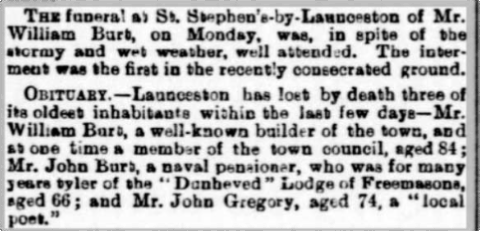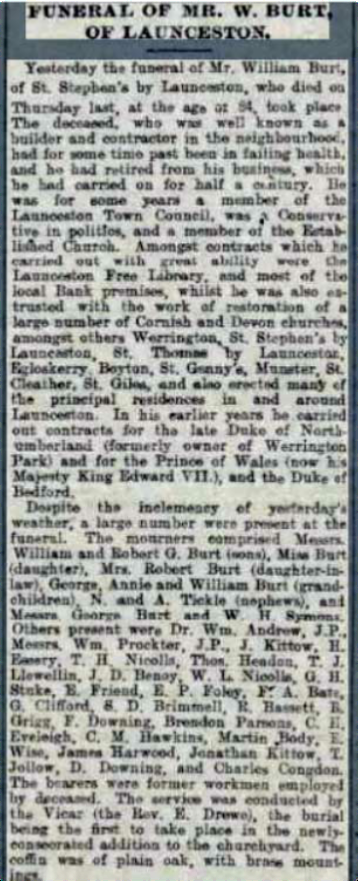.
William was born in 1819 to John and Elizabeth (nee Hean) Burt at St. Stephens, Launceston. He was baptised on December 30th, 1819 at St. Stephens Church.
William married Emily Guppy who came from Dorchester, in 1854 at Launceston. They had three children, William b. 1855, Robert b. 1860. and Annie b. 1857.
William worked as a builder and contractor running his own business from 1853. In 1857 he took over his uncle’s building business.
Post & Weekly News, 14 March, 1857: Advertisement:
W. Burt, jun.
Begs to inform the inhabitants of Launceston and its vicinity,
that he has succeeded his uncle (Mr W Burt) in his Business
of A BUILDER,
in All its branches; and that he is determined to carry out every Order
with which he may be favoured, with all possible economy and despatch.
Dated: NEWPORT, Launceston. February 1857.
Amongst contracts that his firm carried out over the years were the Launceston Free Library, Launceston GWR Railway Station, and most of the Bank premises that we see to this day. He was also entrusted with the work of restoration of a large number of Churches in Cornwall and Devon, amongst others Werrington, St. Stephens-by-Launceston, St. Thomas, Egloskerry, Boyton, St. Gennys, Minster, St. Clether, St. Giles, and he also erected many of the principal properties in and around Launceston. In his earlier days he carried out contracts for the late Duke of Northumberland (formerly owner of Werrington Park), and for the Prince of Wales, and for the Duke of Bedford. His two sons followed into the business. In 1864 a fire destroyed his workshop on St. Stephens Hill.
Launceston Weekly News, April 16th., 1864: St Stephens Fire. On Monday last the workshops in the occupation of Mr W Burt, builder, St Stephens, Launceston, were entirely destroyed by a fire which broke out with great fury while the men were absent at dinner. In a short time the whole premises became the prey of the flames which shot up in immense and lurid volumes, and formed a striking object from Launceston. In less than an hour after the commencement of the fire the roof of the workshop fell in with a crash, the noise of which was plainly heard from the Castle Grounds. The fire engines from Launceston were soon on the spot, but were powerless to combat with the vast body of fire. After completely gutting the premises, which fortunately stood detached, the fire gradually subsided.
Fears were at one time entertained for the safety of Newport House, the wind blowing the flames steadily in that direction. Mr Burt is engaged in rebuilding St Cleather Church, and a large quantity of prepared timber work for that edifice was on the premises, all of which was destroyed. It is reported that the fire was occasioned by a lad placing some shavings in the trunk of a hollow tree near the premises, and igniting the shavings with a match, and the wind blowing in the direction of the workshops, the flames quickly reached them.

He built and lived at Campbell House (above), St Thomas Road, Launceston, in the house that was to become Newport Post Office. He also served for many years upon the Borough Council being a conservative in politics. He was also a staunch member of St. Stephens Church congregation.
He passed away in December 1903 after a long illness and was interred at St. Stephens Churchyard.


Some of the work that William Burt carried out.
The Wesleyan Chapel was restored by Mr William Burt, St Thomas; the architect was Mr Perrow, of London, who also provided the plans for the Davey Monument in Penzance. The Chapel was reopened on Thursday, April 26, 1862. The cost of refurbishment was £1,100.
LAUNCESTON: The building of the Railway Station was commenced on Thursday, last. The contractor is Mr William Burt. The works on the line are progressing rapidly, and it is stated that the line will be open for traffic about Lady-day at the latest. February 1865. East Cornwall Times.
After the fire of 1875, Mr W. Burt rebuilt No’s. 18 and 20 Broad Street, Launceston, now the HSBC Bank, and British Heart Foundation Shop.
1883: Mr W Burt carried out the restoration of St Stephen’s Church. Churchwardens –
Messrs. TC Langdon & Burt.
1886: Mr W. Burt built the new Police Station in Westgate Street, plus in the same year restored Egloskerry Church.
Mr W Burt, surveyor: tenders were invited of Mr Burt regarding St Stephen’s church repairs.
William Burt owned the quarry at the foot of the cliffs below Horse Lane. Arguments arose due to the blasting in the quarry in 1889. Mr CP Wise, the owner of Clifton Villas, complained to the Town Council about the way his house shook from the explosions and of the flying rock.
William Burt, builder, Launceston built the new Spry Mills, Lifton, after the fire of 1893.
1894: On the site of the old Exeter Inn, High Street, William Burt built the new Temperance Hotel now McKays shop.
Jan 6, 1894, C & D: The contract to erect a vicarage at St Stephen’s has been taken by Mr W Burt, of St Stephens, at £1,317. The building will be commenced at once and will give some employment during the winter months. It will be a building of brick, with Polyphant dressings. Messrs Hine & Odgers, Plymouth, are the architects. Mr Williams, Werrington Park granted the fine site at little more than a nominal figure. He is a liberal contributor also to the building.
Mr W Burt, surveyor: tenders were invited of Mr Burt regarding St Stephen’s church repairs.
Jan 6, 1894, C & D: The contract to erect a vicarage at St Stephen’s has been taken by Mr W Burt, of St Stephens, at £1,317. The building will be commenced at once and will give some employment during the winter months. It will be a building of brick, with Polyphant dressings. Messrs Hine & Odgers, Plymouth, are the architects. Mr Williams, Werrington Park granted the fine site at little more than a nominal figure. He is a liberal contributor also to the building.
Campbell House: no doubt named after Alexander Henry Campbell, owner of Werrington Estate from1864, who was bankrupted by the American civil war which upset his cotton trade. MP 1865-68 In 1868 the estate was sold to William Dick, of Wicklow, another cotton merchant of Manchester.
William Burt built the shop next to ‘Locarama’ for George Trethewey, confectioner, to designs by OB Peter, in 1899. (2010 the Laundromat).
Visits: 61
